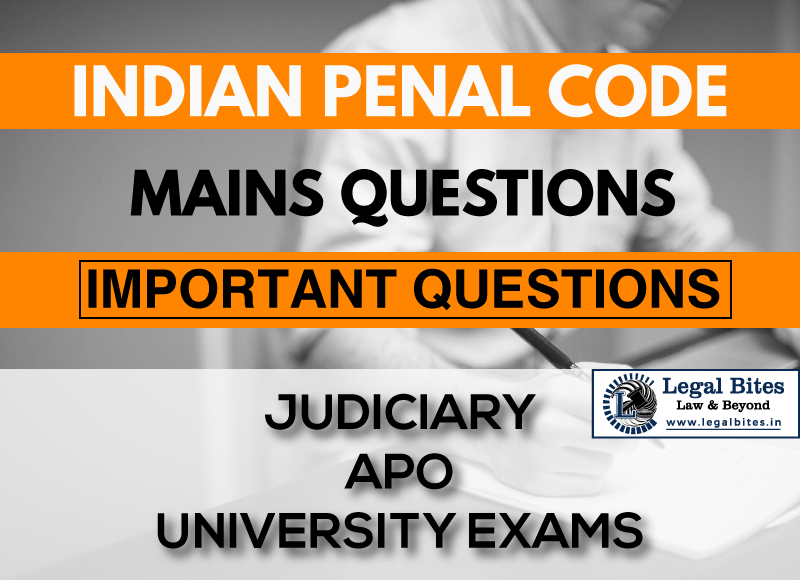Define and distinguish between Force and Criminal Force and Assault giving illustrations.
Find the answer to the mains question only on Legal Bites.

Question: Define and distinguish between Force and Criminal Force and Assault giving illustrations. [RAS. 1980. 1991, CG J.S, 2004. [UPCJ. 1991, 2012, MPCJ 2009] Find the answer to the mains question only on Legal Bites. [Define and distinguish between Force and Criminal Force and Assault giving illustrations.] Answer Section 349, IPC has merely defined force and by itself does not spell out any offence. In fact, force as defined in Section 349, can also be put to positive or good use. ...
Question: Define and distinguish between Force and Criminal Force and Assault giving illustrations. [RAS. 1980. 1991, CG J.S, 2004. [UPCJ. 1991, 2012, MPCJ 2009]
Find the answer to the mains question only on Legal Bites. [Define and distinguish between Force and Criminal Force and Assault giving illustrations.]
Answer
Section 349, IPC has merely defined force and by itself does not spell out any offence. In fact, force as defined in Section 349, can also be put to positive or good use.
For instance, pulling a person away from fire, so as to save him from being burnt, or pushing or dragging a person so as to prevent him from being run down by a vehicle are some examples of force put to good use.
Force becomes ‘criminal force’, only when it satisfies all the ingredients set out in section 350. Section 350, IPC provides a definition of Criminal force.
It states whoever intentionally uses force to any person, without that person’s consent, in order to the committing of any offence, or intending by the use of such force to cause, or knowing it to be likely that by the use of such force he will cause injury, fear or annoyance to the person to whom the force is used, is said to use criminal force to that other.
Force should be used:
- without the consent of the person and in order to the committing of an offence; or
- when it is used to cause injury, fear or annoyance to the person on whom the force is used.
As seen in the definition of ‘force’, criminal force is also concerned with the use of force on a human being alone and not against immovable property or other inanimate objects. Further, the section contemplates the physical presence of the person on whom the force is used.
When the lock of a house was broken in the absence of the occupant of the house, then it is clear that the accused had taken possession of the house without any force or show of force.
But, if a person struck a pot that another person was carrying and which was in contact with his body, it constitutes the offence of criminal force, if it is done to cause him fear, annoyance, etc. Thus, the physical presence of a person makes the crucial difference between an act amounting to ‘criminal force’ or not.
Thus, the use of force which causes motion, change of motion or cessation of motion to another person, done without the consent of such person, in order to commit an offence, or cause injury, fear or annoyance to the said person, will amount to criminal force. No bodily injury or hurt need be caused.
The word ‘intentional’ excludes all involuntary, accidental or even negligent acts. An attendant at a bath, who from pure carelessness turns on the wrong tap and causes boiling water to fall on another, could not be convicted for the use of criminal force.
Further, Assault is a preparatory act that causes apprehension of the use of criminal force but may not require the actual use of criminal force. It creates a fear in the minds of the victim, of violence against him, as intended by the accused.
Section 351 defines Assault as,
Whoever makes any gesture, or any preparation intending or knowing it to be likely that such gesture or preparation will cause any person present to apprehend that he who makes that gesture or preparation is about to use criminal force to that person, is said to commit an assault.
Explanation.—Mere words do not amount to an assault. But the words which a person uses may give to his gestures or preparations such a meaning as may make those gestures or preparations amount to an assault.
For example, A takes up a stick, saying to Z, ‘I will give you a beating’. Here, though the words used by A could in no case amount to an assault, and though the mere gesture, unaccompanied by any other circumstance, might not amount to an assault, the gesture explained by the words may amount to an assault.
Therefore, all three terms Force, Criminal Force and Assault are defined separately and are different. They are the stages leading to the commission of a crime and might affect it differently.
Important Mains Questions Series for Judiciary, APO & University Exams
- IPC Mains Questions Series Part I: Important Questions
- IPC Mains Questions Series Part II: Important Questions
- IPC Mains Questions Series Part III: Important Questions
- IPC Mains Questions Series Part IV: Important Questions
- IPC Mains Questions Series Part V: Important Questions
- IPC Mains Questions Series Part VI: Important Questions
- IPC Mains Questions Series Part VII: Important Questions
- IPC Mains Questions Series Part VIII: Important Questions
- IPC Mains Questions Series Part IX: Important Questions
- IPC Mains Questions Series Part X: Important Questions
Admin Legal Bites
Legal Bites Study Materials correspond to what is taught in law schools and what is tested in competitive exams. It pledges to offer a competitive advantage, prepare for tests, and save a lot of money.

